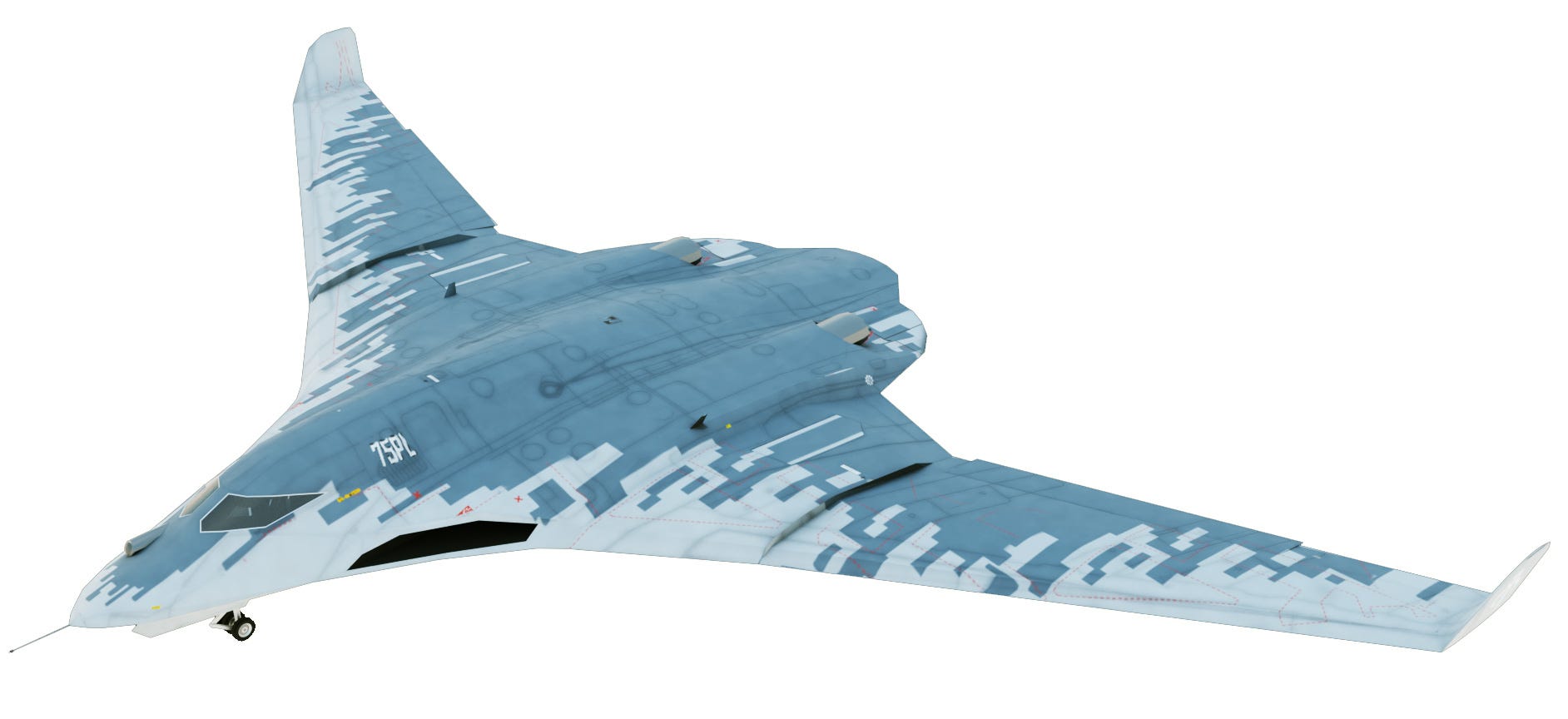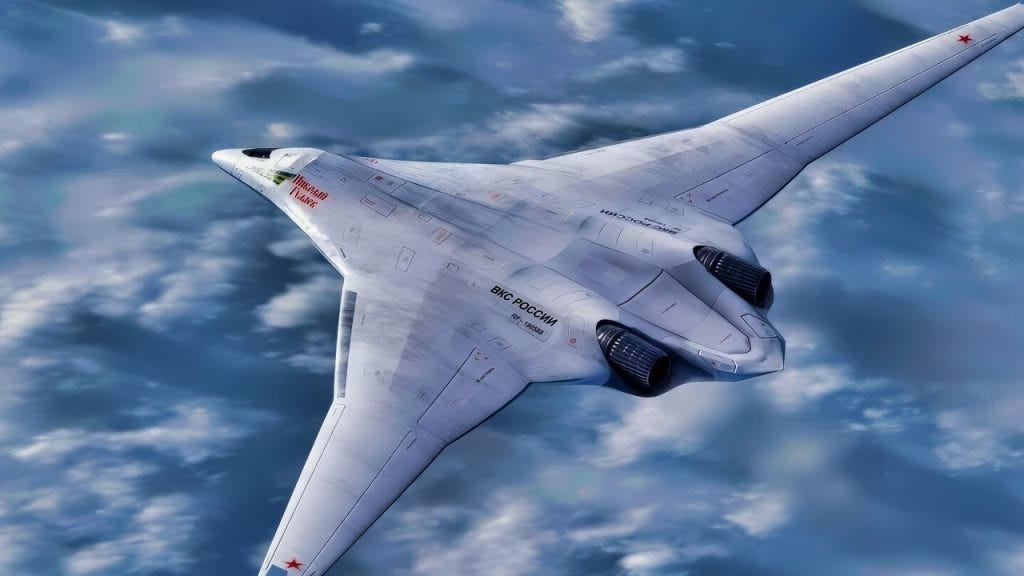Russia’s “Stealth” Bomber Program Was So Secret, Even Russia Couldn’t Find the Parts
Hackers gave us an inside look at the development troubles
If you’ve been wondering what Russia’s long-promised stealth bomber, the mythical PAK DA, has been up to lately, the answer is: leaking.
Not radar signatures, mind you. Actual data. A new cyber operation has pulled back the curtain on Moscow’s most classified aviation projects, and what’s underneath looks less like cutting-edge stealth and more like a scrapyard with delusions of grandeur.
The leak, published by InformNapalm and the cyber unit Fenix, exposed internal files from Russia’s defense industry, including technical documentation for both the PAK DA “Poslannik” strategic bomber and the Su-57 fighter jet.
The hackers didn’t just grab a few slide deck templates, they got blueprints, correspondence, and procurement trails. And the damning story those documents tell isn’t one of stealth, it’s one of dependence.
Turns out Russia’s flagship aerospace projects are running on Taiwanese milling machines, Serbian grinders, and Western components sneaked in through front companies. In other words, the “indigenously developed” stealth bomber is about as Russian as a California Tesla fitted with IKEA parts.
PAK DA: The Bomber That Exists Mostly in силовая установка (Russian Power Point)
The PAK DA, short for Prospective Aviation Complex for Long-Range Aviation, was supposed to be the crown jewel of Russia’s strategic bomber fleet. A flying-wing design meant to replace the Cold War relics Tu-95 “Bear” and Tu-160 “Blackjack,” it was envisioned as a radar-evading, subsonic platform capable of carrying nuclear or conventional payloads.
The project first appeared on drawing boards in the early 2000s, back when Farmville was cutting edge and Vladimir Putin still pretended to believe in term limits. Two decades later, the PAK DA remains more concept than aircraft. It’s been through so many redesigns and funding freezes that even Tupolev engineers joke it has more “prospective” than “aviation.”
The new leaks reveal one of the more tragi-comic details: the technical specs for the PAK DA’s hydraulic actuators, the parts that open its bomb bay doors.
In Western stealth bombers, these are precision-engineered components made to whisper open with almost no radar signature. In Russia, the documents show Tupolev contracted OKBM, a machine-tool company already underperforming and dependent on foreign CNC equipment.
So, if the bomber ever makes it to production, the most secret part of Russia’s stealth system might be its import invoices.
Sanctions vs. Sanity
The documents show that OKBM relies on Taiwan-made Hartford HCMC-1100AG milling machines, Johnford SL-50 lathes, and a Serbian Grindex BSD-700U CNC grinder. These were bought with subsidies from Russia’s Ministry of Industry and Trade, because apparently nothing screams “strategic autonomy” like relying on Taiwanese equipment during a sanctions war.
After Western suppliers pulled out, OKBM scrambled to find alternatives, leading to what the audit reports politely called “production delays.”
That’s bureaucratic Russian for nothing works and everyone’s lying about it. The Kremlin keeps promising that “import substitution” will save the defense industry. In reality, their engineers are standing over broken lathes muttering “slava Rossii” while checking AliExpress.
By late October, the European Union finally added OKBM to its 19th sanctions package, officially recognizing it as a critical node in Russia’s defense chain and a repeat offender in sanction evasion. Too little, too late. By that point, the machines had already cut parts for both the Su-57’s weapon bays and PAK DA’s actuators.
Western taxpayers can rest easy knowing they may have unwittingly helped build the next generation of targets for Ukrainian drones.

The Ghost Fleet of Kazan
Russia keeps talking about ramping up aircraft production at the Kazan Aviation Plant, where the PAK DA is supposed to be assembled. State TV shows shiny hangars and animated mockups while ignoring the part where the actual production lines are empty or repurposed for coffee breaks.
In theory, Kazan is churning out next-gen bombers. In practice, it’s refurbishing Tu-160 airframes last updated when disco was still fashionable. The PAK DA’s supposed rollout has slipped from 2020 to 2025 to “sometime before 2030.” With each missed deadline, the Kremlin blames sanctions, saboteurs, or “temporary logistics issues.” The one thing it never blames is the obvious: corruption and incompetence.
At this rate, the PAK DA’s first flight will coincide with Putin’s first honest election. Ahem… that is, never.
The Su-57’s Not-So-Secret Struggle
The same leak exposed documents on the Su-57 Felon, Russia’s supposed fifth-generation stealth fighter. Moscow touts it as an equal to the American F-22 and F-35. In reality, it’s a boutique item, fewer than twenty operational units, most of them plagued by engine issues and radar cross sections big enough to make a C-130 blush.
The leaked gearbox-joint designs for the Su-57’s weapon bays show OKBM’s fingerprints all over the supply chain. These are not optional parts. Without them, the fighter’s internal weapons storage, key to its stealth, is useless. Imagine an F-35 whose bomb bay doors jam halfway open. That’s not stealth; that’s a flying “shoot me” sign.
Before the 2022 invasion of Ukraine, Russia was believed to have achieved some degree of advanced weapon system development. Russia analysts and former Air Force chums who now work at the CIA and DIA have told me, on background, that before the Ukraine War they took Russia’s threats at face value.
That, my friends, is shocking to me. Because Russia under Putin is known for inflated propaganda promises that rarely materialize.
The Felon, the Poseidon nuclear torpedo, the Skyfall nuclear cruise missile: These were all supposed examples of Russia’s obvious technological prowess. I told them not to feel so bad; even the New York Times got it dead wrong.
The truth is that aside from a few “super weapon” prototypes, the entire Russian MoD has been hollowed out from corruption; even after Putin’s so-called “reforms” in the mid-2000s.
I would even question whether half of their nuclear deterrent is still operational, knowing how expensive it is to maintain those things. Indeed, the nukes would be the easiest weapon system to divert funds away from because nobody’s going to use them anyways and if they try, well, the world has bigger things to worry about than the colonel’s new yacht in Cyprus.
InformNapalm’s investigators dubbed the operation “OKBMLeaks,” promising it’s only the first drop in a larger data flood. And it matters, not just because it embarrasses Moscow, but because it confirms what defense analysts have suspected since 2022: Russia’s “independent” military-industrial complex is a façade held together by foreign components and creative accounting.
While the Kremlin loves to parade prototypes and promise revolutions in warfare, the reality is that its defense sector runs on scavenged technology and stolen code. The PAK DA might one day roll out of a hangar, but by then the rest of the world will be fielding sixth-generation aircraft, and Russia will still be arguing about where to get replacement parts for its Taiwanese CNC machines.
For years, Putin has sold the illusion that Russia could field a fully domestic, world-class defense industry immune to Western pressure. The PAK DA leaks blow that illusion apart. The empire that once produced the MiG-29 and Su-27 now struggles to manufacture door hydraulics without imported parts.
The irony writes itself: the “stealth bomber” project that was supposed to terrify NATO now exists mainly as a PDF in Ukrainian intelligence folders. The only thing invisible about it is progress.
Meanwhile, Ukrainian drone units are flying locally assembled aircraft that actually work; built with open-source parts, field-tested under fire, and maintained by crews who don’t need a sanction-dodging front company to order bolts.
That’s the real divide in modern warfare. Russia builds fantasy; Ukraine builds function.
If the PAK DA ever takes flight, it won’t be a triumph of Russian engineering, it’ll be a flying museum exhibit of everything sanctions couldn’t stop and everything corruption already did.
Until then, the Kremlin’s stealth bomber remains perfectly invisible… Because it doesn’t exist.
Слава Україні!




Maybe Ukraine bombed parts of it
“the nukes would be the easiest weapon system to divert funds away from because nobody’s going to use them anyways and if they try, well, the world has bigger things to worry about than the colonel’s new yacht in Cyprus.”
What a brilliant piece of writing this is!! Gave me a good laugh, and is spot on.
I really appreciate the effort you put in Wes. I hope you are making a living with your work, because I think it’s the best mil-related material online. Great technical insights. Unlike other writers, you seem to actually possess the technical expertise they grab and go from Chat and Grok. Even more importantly you don’t lard your work with ad hominem political attacks and naive economic scrawl like others.
Keep up the good work!